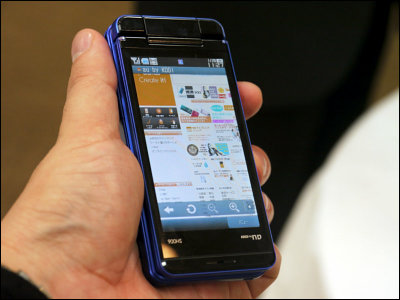NTT DoCoMo explained "mobile space statistics" that cell phone users grasp "when and where they are" and utilize them in all fields

In today's Japanese society, mobile phones are becoming an indispensable presence, but NTT Docomo, which has overwhelming users of over 56 million people,What kind of layer, what kind of time and what kind of place are you?"Society" will be visible by grasping "Mobile Spatial StatisticsWe made an announcement about.
"Being able to grasp the movement of a person" has a great meaning to society in all aspects such as disaster prevention and industry, but in fact it does not mean that the population distribution throughout the country, the population composition in a specific place, Imaged demonstrations are carried out, and it is easy to understand what "mobile space statistics" are like.
Details are as below.
A recital was held today in Tokyo for reporters.
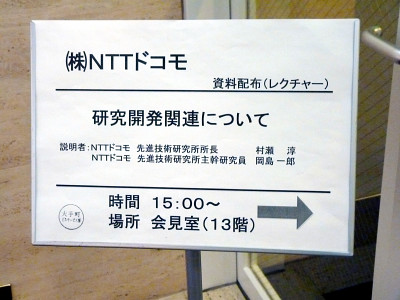
Mr. Atsushi Murase Director, NTT DoCoMo Advanced Technology Laboratory
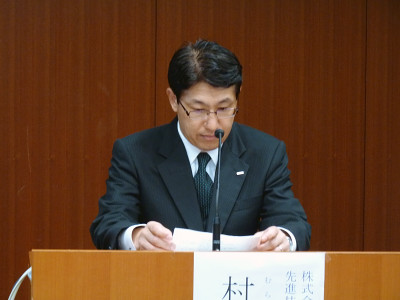
Mr. Ichiro Okajima, NTT DoCoMo Advanced Network Systems Research Group, Advanced Technology Laboratory
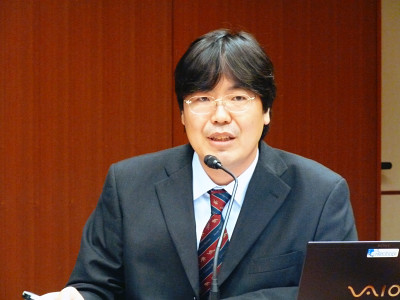
Mr. Kenichi Mori Manager, Mid-Term Strategy Department, Corporate Planning Department, NTT DoCoMo
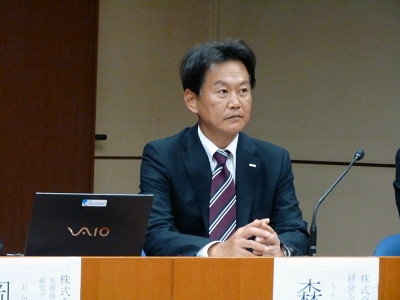
Part-time lecturer at the University of Tokyo and deputy director of Urban Design Center Kashiwanoha 3 Makihiro Hayao
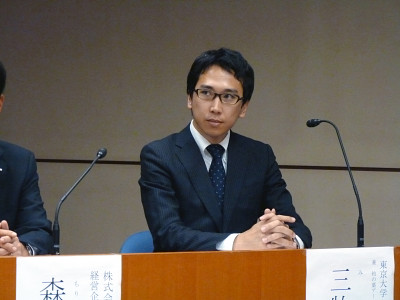
This is the mechanism of "mobile space statistics". Although the cellular phone periodically communicates with the base station, by combining the user information with the location information of the base station, "what kind of layer, what time, what kind of place is located" Can be converted into statistical data.
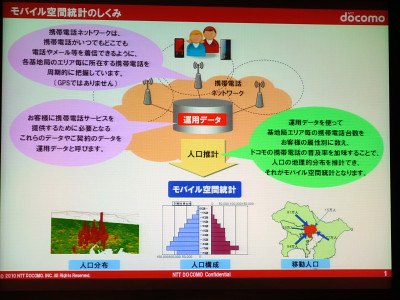
A demonstration was held to explain what "mobile space statistics" actually is. It is possible to image the population distribution nationwide, population composition in a specific place, population migrating, etc.
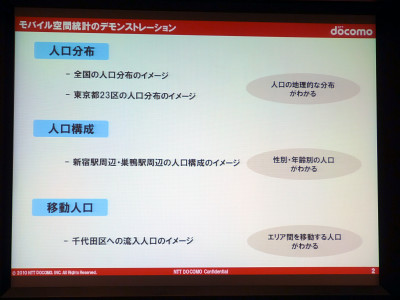
Image of population distribution throughout Japan. It is like 2 o'clock in the morning on weekdays that most people think that they are sleeping at home.
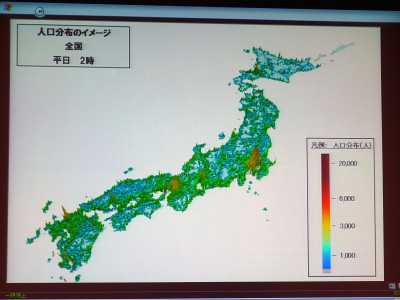
As you can see in the morning at 8 o'clock, the population of the three metropolitan areas of Tokyo, Nagoya and Osaka is increasing.
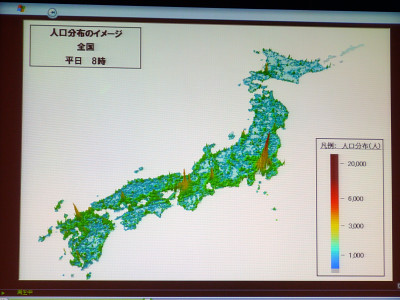
Weekday 15 o'clock. It is remarkable that the population is gathering in urban areas.
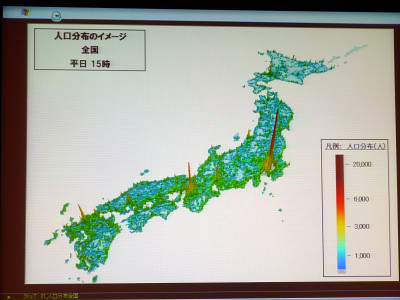
20:00. The population that was consolidated in urban areas has begun to decline. In other words, it means that many people are starting to go back to the suburbs.

This time it is easier to understand, population distribution around the main terminals in Tokyo such as Shibuya, Shinjuku, Ikebukuro, Ueno, Tokyo. Despite the fact that it is 4 o'clock in the morning on weekdays, there are more people in Shinjuku and in the vicinity of Tokyo.
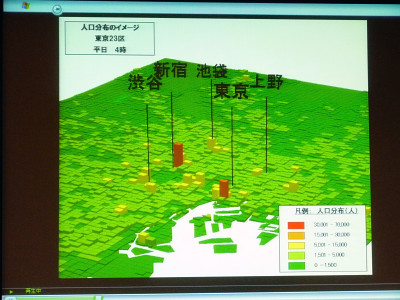
At 8 o'clock in the morning the population is growing at once. The population growth of Tokyo etc. where the company is dense is remarkable.

It's 9 am. The population is increasing further.
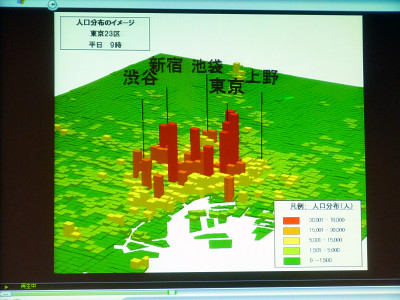
12 o'clock. If you look closely you can see that the population is densely populated also in the Saitama area.
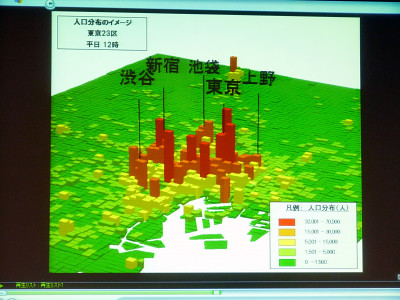
17 o'clock. There are still many people in Tokyo, but the population of the Saitama district has increased more than 12 o'clock, and the population of Shinjuku has also increased significantly. Is it due to young people such as students who finished classes?
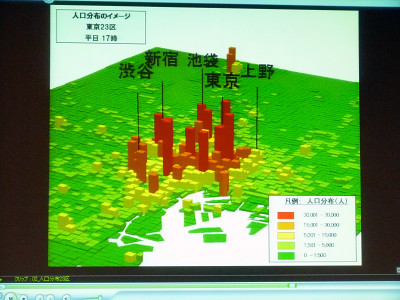
19o'clock. Whether an office worker who finished work starts to go home, symmetrically to the fact that the population in the neighborhood of Tokyo starts decreasing, many people are gathering at a terminal with entertainment areas such as Shibuya, Shinjuku and Ikebukuro.

At 20 o'clock, the population around Tokyo decreased visibly. People start to decrease from each terminal.
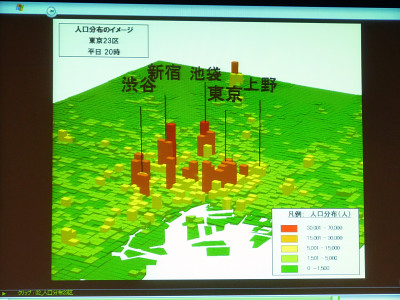
23:00. After many people came home. The population difference with daytime is remarkable, is not it ... ?.

Furthermore, comparing the population composition of "Shinjuku" popular among young people and the popular city "Sugamo" centered on elderly people. It is like this at 12 o'clock on weekdays. In Shinjuku and Sugamo, the population itself is too different, but the difference in age group is very interesting.
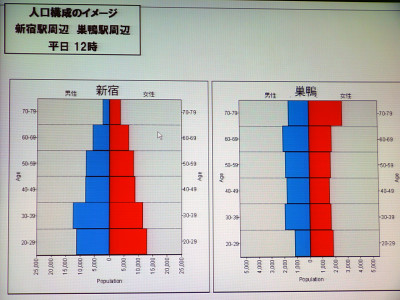
At 20 o'clock, Shinjuku will become a more extreme pyramid-shaped population.
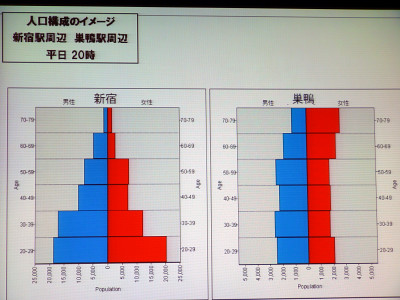
Lastly, the influx population to Chiyoda Ward, Tokyo. At 3 o'clock on weekdays there are few migrants.
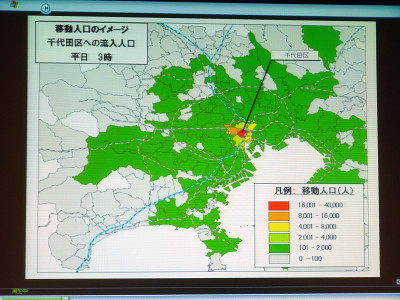
It's nine in the morning. I can see that the population is flowing in at a stretch.

The situation is almost the same even at 15 o'clock.
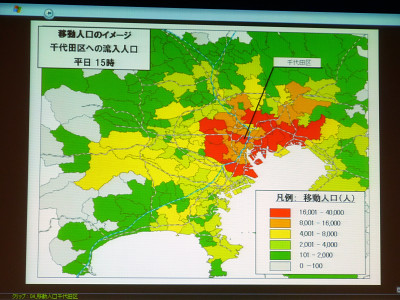
But I can see that it is decreasing at 19 o'clock. In this way, using "mobile space statistics" it is possible to statistically grasp the movement of people.

Procedure for creating "Mobile Spatial Statistics". Since it is demographics that only shows the number of people in a group, it is a mechanism that can not identify individual users. In addition, NTT DoCoMo has formulated the "Mobile Spatial Statistics Guidelines" as a voluntary rule.
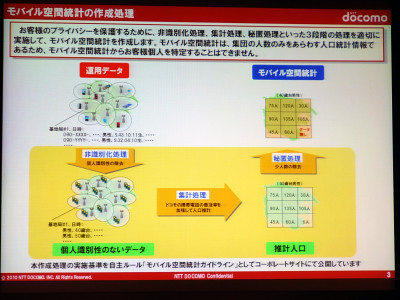
Since 'Mobile Space Statistics' uses mobile phones, the statistical information depends on the service area of FOMA and the installation interval of base stations.

The image of the future is like this. Town development and disasterDifficulty going homeIt is expected to live in all sectors such as contributing to economic development by utilizing it in the public field, academic research field, which has benefits to society as a whole, such as grasp of the science research field, and marketing information in the industrial field It is being done.
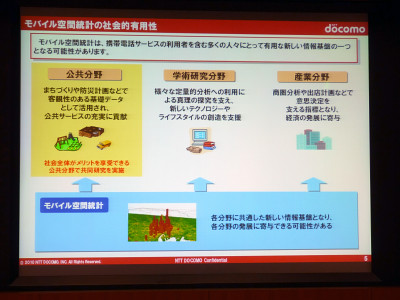
NTT DoCoMo will verify the usefulness of the "Mobile Spatial Statistics" in the town development field between November 1, 2010 and March 31, 2011 in the city of Kashiwa, Chiba Prefecture.
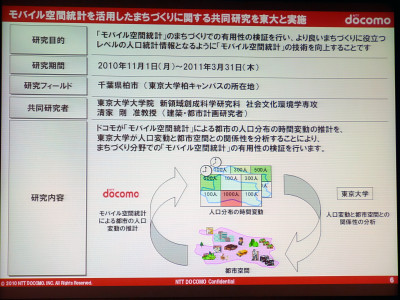
Image of collaborative research. Estimating changes in the population by attribute according to the season, day of the week, time in Kashiwa City, and analyzing the relationship between the facilities in Kashiwa City and the population change, and planning effective utilization of urban space is.

In addition, this research is proceeding with reference to the results of examinations by experts outside NTT DoCoMo "Study Group on Social and Industrial Development by Mobile Space Statistics".
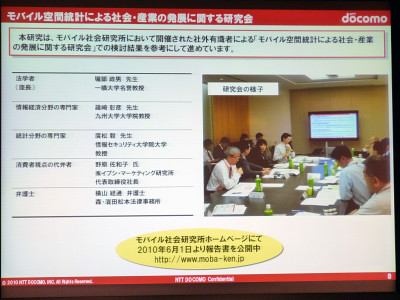
Questions and answers made at the venue are as follows.
Mainichi newspaper Kojima:
Is it about providing mobile space statistics to society in the future?
NTT DoCoMo:
It is now.
Kojima:
"Industry field" has come out, will you provide data to companies that want to use for marketing for a fee?
NTT DoCoMo:
First of all, it is the stage of checking in collaborative research whether the reliability of data etc. has reached a sufficient level. Regarding practical application, we may proceed from the public sector, verify it, and then expand it to the industrial field in the future.
The census only shows data only for the daytime population (company and school time zone) and nighttime population (household time zone) as of October 1 every 4 years, but "Mobile Spatial Statistics As we can obtain more information, we will proceed with the verification of data reliability.
Sekiguchi of mobile phone Watch:
To say field test in Kashiwa city, is it to check the flow of population in Kashiwa? Will it be data that can be utilized for town planning in other areas, is it to verify from now?
NTT DoCoMo:
It also covers migrating population, population distribution, composition and so on. For the rest of the city other than Kashiwa City, I think that there are parts that depend on Kashiwa City in the field study of Kashiwa this time and some parts that can be applied in other cities, but we plan to develop results in the future.
Watanabe of the Nihon Keizai Shimbun:
What is the timing of business development? Do you explain using data to contractors? It seems that elderly people do not use mobile phones so much, but what do you think about the unused layers?
NTT DoCoMo:
As a research institute, I can not say how far it will be developed as a business, but I want to be able to make a contribution to the business as soon as possible. However, because there are many parts to verify, it can not be said quickly. Regarding explanations to contractors, we have formulated our own rules, and we are considering notifying users that we will collaborate with the University of Tokyo. We plan to set up a call center as well.
As for the elderly, there are places that you have certainly pointed out, and there are cases where you contract with the family name, not the name of the elderly, so I would like to validate this collaborative research.
Okamoto of NHK Science Culture Division:
Is this the first such study, including au and Softbank? How do you confirm whether the data conforms to the actual situation of the user in the first place?
NTT DoCoMo:
As far as we are grasping, it is our first effort. For data confirmation method obtained from "Mobile Space Statistics", we plan to make use of various data of the city, for example, if there is data such as "Survey on the actual use of the park", we will transfer that data and "Mobile Spatial Statistics" By comparing, you can check.
The press release of NTT docomo is below.
Press release presentation: Collaborative research on town planning utilizing 'Mobile Space Statistics' with University of Tokyo | Notice | NTT DoCoMo
Related Posts:
in Coverage, Mobile, Web Service, Posted by darkhorse_log


